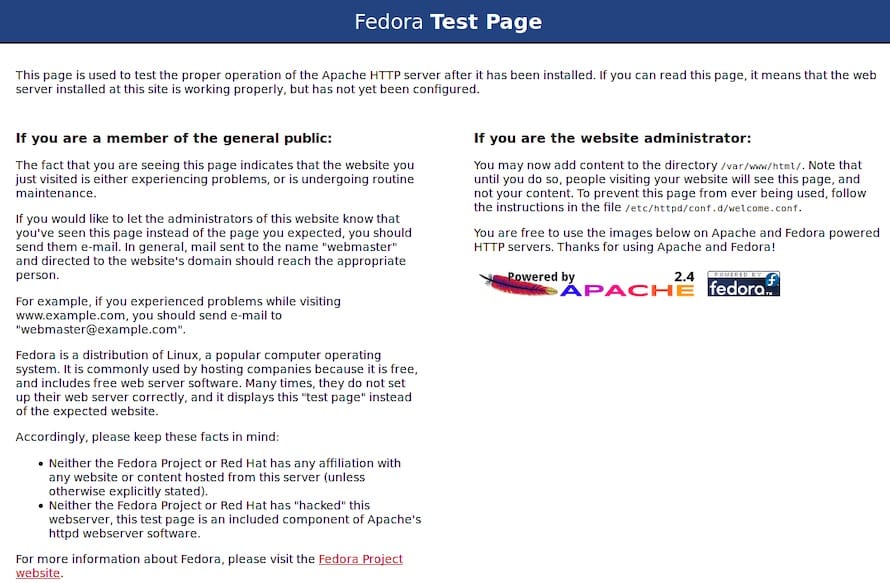How To Install Apache on Fedora 41

Apache HTTP Server, commonly known as Apache, is one of the most popular and widely-used web servers in the world. Its reliability, flexibility, and robust feature set make it an excellent choice for hosting websites and web applications. Fedora 41, the latest release of the community-driven Linux distribution, provides a stable and secure platform for running Apache.
In this comprehensive guide, we’ll walk you through the process of installing Apache on Fedora 41, from the initial setup to advanced configuration and optimization. Whether you’re a seasoned system administrator or a beginner looking to set up your first web server, this article will provide you with the knowledge and tools you need to get Apache up and running smoothly on your Fedora 41 system.
Prerequisites
Before we dive into the installation process, let’s ensure you have everything you need to successfully install and configure Apache on Fedora 41:
- System Requirements: Fedora 41 installed on your machine (physical or virtual)
- Permissions: Root or sudo access to execute administrative commands
- Internet Connection: A stable internet connection for downloading packages
- Updated System: Ensure your Fedora 41 system is up to date
To update your Fedora 41 system, open a terminal and run the following command:
sudo dnf update -yThis command will update all installed packages to their latest versions, ensuring compatibility and security.
Installing Apache on Fedora 41
Fedora 41 uses the DNF (Dandified Yum) package manager, which makes installing Apache a straightforward process. Follow these steps to install Apache:
1. Using DNF Package Manager
Open a terminal and run the following command to install Apache:
sudo dnf install httpd -yThis command installs the Apache web server package (httpd) and its dependencies.
2. Verifying the Installation
After the installation is complete, verify that Apache was installed correctly by checking its version:
httpd -vYou should see output similar to this:
Server version: Apache/2.4.x (Fedora)
Server built: MMM DD YYYY HH:MM:SS3. Starting and Enabling Apache Service
To start the Apache service and enable it to start automatically on system boot, run these commands:
sudo systemctl start httpd
sudo systemctl enable httpdVerify that Apache is running with:
sudo systemctl status httpdYou should see “active (running)” in the output, indicating that Apache is now running on your Fedora 41 system.
Configuring Apache
With Apache installed and running, let’s explore its configuration to customize it for your needs.
Understanding Configuration Files
Apache’s main configuration file on Fedora 41 is located at /etc/httpd/conf/httpd.conf. Additional configuration files are stored in the /etc/httpd/conf.d/ directory. Here’s a brief overview of important files:
httpd.conf: Main configuration filewelcome.conf: Configuration for the default welcome pagessl.conf: SSL/TLS configuration (if installed)userdir.conf: Configuration for user directories
Basic Apache Configuration
To make basic changes to your Apache configuration, edit the main configuration file:
sudo nano /etc/httpd/conf/httpd.confSome common settings you might want to adjust include:
ServerAdmin: Set the server administrator’s email addressDocumentRoot: Specify the directory where your web files are storedListen: Change the port Apache listens on (default is 80)
After making changes, save the file and restart Apache for the changes to take effect:
sudo systemctl restart httpdSetting Up Virtual Hosts
Virtual hosts allow you to host multiple websites on a single Apache server. To set up a virtual host:
- Create a new configuration file in
/etc/httpd/conf.d/:sudo nano /etc/httpd/conf.d/example.com.conf - Add the following configuration (adjust as needed):
<VirtualHost *:80> ServerName example.com ServerAlias www.example.com DocumentRoot /var/www/example.com ErrorLog /var/log/httpd/example.com-error.log CustomLog /var/log/httpd/example.com-access.log combined </VirtualHost> - Create the document root directory:
sudo mkdir -p /var/www/example.com - Set appropriate permissions:
sudo chown -R apache:apache /var/www/example.com sudo chmod -R 755 /var/www/example.com - Restart Apache:
sudo systemctl restart httpd
Testing Apache Installation
Now that Apache is installed and configured, let’s test it to ensure everything is working correctly.
Creating a Test Page
Create a simple HTML file to serve as your test page:
sudo nano /var/www/html/index.htmlAdd the following content:
<!DOCTYPE html>
<html lang="en">
<head>
<meta charset="UTF-8">
<meta name="viewport" content="width=device-width, initial-scale=1.0">
<title>Apache Test Page</title>
</head>
<body>
<h1>Welcome to Apache on Fedora 41!</h1>
<p>If you can see this page, Apache is working correctly.</p>
</body>
</html>Accessing the Default Page
Open a web browser and navigate to http://localhost or your server’s IP address. You should see the test page you created.

Troubleshooting Common Issues
If you encounter issues accessing the test page, try the following:
- Check Apache status:
sudo systemctl status httpd - Verify firewall settings:
sudo firewall-cmd --list-all - Check error logs:
sudo tail -f /var/log/httpd/error_log
Securing Apache
Security is crucial for any web server. Let’s explore some ways to enhance Apache’s security on Fedora 41.
Implementing SSL/TLS
To enable HTTPS, you’ll need to install mod_ssl and generate an SSL certificate:
- Install mod_ssl:
sudo dnf install mod_ssl - Generate a self-signed certificate (for testing purposes):
sudo openssl req -x509 -nodes -days 365 -newkey rsa:2048 -keyout /etc/pki/tls/private/apache-selfsigned.key -out /etc/pki/tls/certs/apache-selfsigned.crt - Edit the SSL configuration file:
sudo nano /etc/httpd/conf.d/ssl.conf - Update the SSLCertificateFile and SSLCertificateKeyFile directives to point to your new certificate and key.
- Restart Apache:
sudo systemctl restart httpd
Configuring Firewall Rules
Ensure that your firewall allows incoming traffic on ports 80 (HTTP) and 443 (HTTPS):
sudo firewall-cmd --permanent --add-service=http
sudo firewall-cmd --permanent --add-service=https
sudo firewall-cmd --reloadBest Practices for Apache Security
- Keep Apache and Fedora 41 updated regularly
- Use strong passwords for server access
- Implement ModSecurity for web application firewall protection
- Disable directory listing to prevent information disclosure
- Use SELinux to enforce access controls
Performance Tuning
Optimizing Apache’s performance can significantly improve your website’s speed and responsiveness.
Optimizing Apache Configuration
Edit the main Apache configuration file to adjust performance settings:
sudo nano /etc/httpd/conf/httpd.confConsider the following optimizations:
- Adjust
KeepAlivesettings to reduce server load - Optimize
MaxKeepAliveRequestsandKeepAliveTimeout - Fine-tune
MPM(Multi-Processing Module) settings based on your server’s resources
Implementing Caching Mechanisms
Enable and configure mod_cache to improve response times:
- Install mod_cache:
sudo dnf install mod_cache - Create a new configuration file:
sudo nano /etc/httpd/conf.d/cache.conf - Add basic caching configuration:
CacheQuickHandler off CacheLock on CacheLockPath /tmp/mod_cache-lock CacheLockMaxAge 5 CacheIgnoreHeaders Set-Cookie <IfModule mod_cache_disk.c> CacheRoot /var/cache/httpd/proxy CacheEnable disk / CacheDirLevels 2 CacheDirLength 1 </IfModule> - Restart Apache:
sudo systemctl restart httpd
Monitoring Apache Performance
Use tools like Apache Bench (ab) or siege to benchmark your server’s performance. For real-time monitoring, consider installing and configuring mod_status.
Advanced Apache Features
Apache offers numerous advanced features to enhance your web server’s functionality.
Enabling Modules
Apache’s modular architecture allows you to extend its capabilities. To enable a module:
- Install the module (if not already installed):
sudo dnf install mod_[module_name] - Enable the module:
sudo ln -s /etc/httpd/conf.modules.d/[module_config_file] /etc/httpd/conf.modules.d/[module_name].conf - Restart Apache:
sudo systemctl restart httpd
Configuring mod_rewrite
mod_rewrite is a powerful tool for URL manipulation. To use it:
- Ensure mod_rewrite is enabled
- Create or edit your .htaccess file:
sudo nano /var/www/html/.htaccess - Add rewrite rules, for example:
RewriteEngine On RewriteRule ^about$ about.html [NC,L]
Setting Up Reverse Proxy
Apache can act as a reverse proxy, forwarding requests to other servers:
- Enable necessary modules:
sudo dnf install mod_proxy mod_proxy_http - Configure the proxy in your virtual host:
<VirtualHost *:80> ProxyPass / http://backend-server:8080/ ProxyPassReverse / http://backend-server:8080/ </VirtualHost> - Restart Apache
sudo systemctl restart httpdCongratulations! You have successfully installed Apache. Thanks for using this tutorial for installing the Apache web server on your Fedora 41 system. For additional or useful information, we recommend you check the official Apache website.